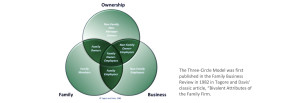Family Business Under New Management
Seth Godin recently posted a blog entitled: Under New Management. In it he wrote:
“That’s a pretty silly thing to write on the store window.
It says to loyal customers, “watch out, someone new is in charge.”
And it says to strangers and the apathetic, “this place failed.”[1]
How often do you see a sign on a store reading: “Family Business: Under New Management?” We rarely do. But what would it mean if we did?
The most likely interpretation is that the business transitioned from one generation to the next. That’s significant. But there are other important ways a family business can come to be under new management.
The three-circle model of family business developed by Renato Tagiuri and John Davis in 1978, describes three interdependent and overlapping components of the family business system: the business, the family, and the ownership. In each of these, new learning, under new management can occur every day.
Business owners recognize improvements can always be made to their management and operational practices. But the family and ownership subsystems are often overlooked.
We have come to recognize that multi-generational success of family business is dependent upon a co-evaluation and perhaps “new management” of each of these systems, and their complex interactions.
Godin continues: “If you think about it, though, every day, every store is under new management, if we define ‘new’ to mean, “we learned from what happened yesterday.”[2]
[1] Under New Management. Retrieve from: https://seths.blog/2020/03/under-new-management-2/
[2] Ibid.

